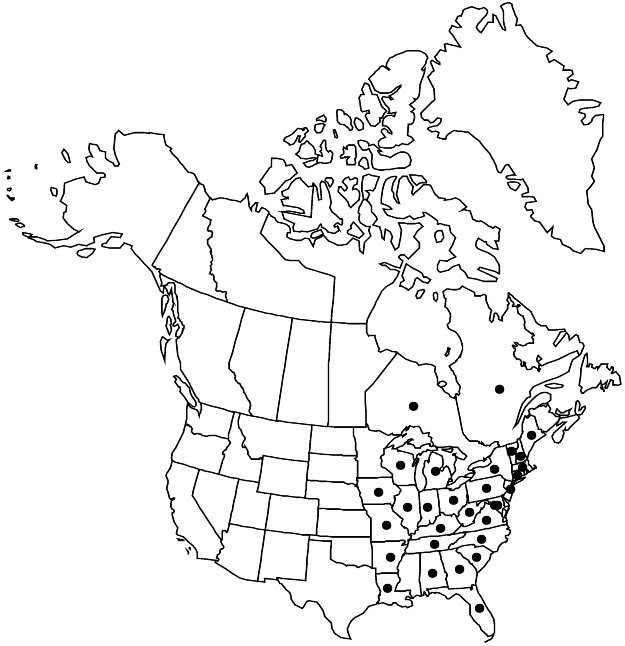Difference between revisions of "Sedum sarmentosum"
Enum. Pl. China Bor., 30. 1833 ,.
FNA>Volume Importer |
imported>Volume Importer |
||
| (One intermediate revision by the same user not shown) | |||
| Line 7: | Line 7: | ||
}} | }} | ||
|common_names=Orpin sarmenteux | |common_names=Orpin sarmenteux | ||
| + | |special_status={{Treatment/ID/Special_status | ||
| + | |code=I | ||
| + | |label=Introduced | ||
| + | }} | ||
|basionyms= | |basionyms= | ||
|synonyms= | |synonyms= | ||
| Line 23: | Line 27: | ||
|elevation=0-500 m | |elevation=0-500 m | ||
|distribution=Ont.;Que.;Ala.;Ark.;Conn.;D.C.;Fla.;Ga.;Ill.;Ind.;Iowa;Ky.;La.;Maine;Md.;Mass.;Mich.;Mo.;N.H.;N.J.;N.Y.;N.C.;Ohio;Pa.;S.C.;Tenn.;Vt.;Va.;W.Va.;Wis.;e Asia (China);introduced also in c;e Europe. | |distribution=Ont.;Que.;Ala.;Ark.;Conn.;D.C.;Fla.;Ga.;Ill.;Ind.;Iowa;Ky.;La.;Maine;Md.;Mass.;Mich.;Mo.;N.H.;N.J.;N.Y.;N.C.;Ohio;Pa.;S.C.;Tenn.;Vt.;Va.;W.Va.;Wis.;e Asia (China);introduced also in c;e Europe. | ||
| + | |introduced=true | ||
|discussion=<p><i>Sedum sarmentosum</i> has flowering shoots that are usually reddish. It is naturalized in North America, and in central and eastern Europe.</p> | |discussion=<p><i>Sedum sarmentosum</i> has flowering shoots that are usually reddish. It is naturalized in North America, and in central and eastern Europe.</p> | ||
|tables= | |tables= | ||
| Line 46: | Line 51: | ||
|publication title=Enum. Pl. China Bor., | |publication title=Enum. Pl. China Bor., | ||
|publication year= | |publication year= | ||
| − | |special status= | + | |special status=Introduced |
| − | |source xml=https:// | + | |source xml=https://bitbucket.org/aafc-mbb/fna-data-curation/src/2e0870ddd59836b60bcf96646a41e87ea5a5943a/coarse_grained_fna_xml/V8/V8_442.xml |
|genus=Sedum | |genus=Sedum | ||
|species=Sedum sarmentosum | |species=Sedum sarmentosum | ||
Latest revision as of 22:43, 5 November 2020
Herbs, perennial, mat-forming, glabrous. Stems creeping and ascending, branched, not bearing rosettes. Leaves in whorls of 3, spreading, sessile; blade pale yellowish green, not glaucous, narrowly rhombic-elliptic to widely lanceolate, subterete, 10–25 × 4–6 mm, base spurred, not scarious, apex subacute. Flowering shoots creeping or ascending, simple, 10–25 cm; leaf blades narrowly oblanceolate-elliptic, base short-spurred; offsets not formed. Inflorescences dense cymes or corymbs, 8–40-flowered, (1–)2–4-branched; branches spreading to widely ascending, sometimes forked; bracts similar to leaves, smaller. Pedicels absent or to 0.5 mm. Flowers 5-merous; sepals spreading, distinct basally, green, widely lanceolate to oblong, often unequal, 3.5–5 × 0.8–1.5 mm, apex acute or obtuse; petals spreading, slightly connate, yellowish, lanceolate to oblong, not carinate, 5–8 mm, apex long-mucronate; filaments yellow; anthers reddish; nectar scales orange, rectangular-spatulate. Carpels stellately patent in fruit, distinct, yellow-green. 2n = ca. 72.
Phenology: Flowering spring.
Habitat: Xeric rock outcrops
Elevation: 0-500 m
Distribution

Introduced; Ont., Que., Ala., Ark., Conn., D.C., Fla., Ga., Ill., Ind., Iowa, Ky., La., Maine, Md., Mass., Mich., Mo., N.H., N.J., N.Y., N.C., Ohio, Pa., S.C., Tenn., Vt., Va., W.Va., Wis., e Asia (China), introduced also in c, e Europe.
Discussion
Sedum sarmentosum has flowering shoots that are usually reddish. It is naturalized in North America, and in central and eastern Europe.
Selected References
None.